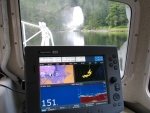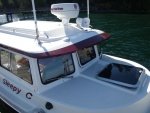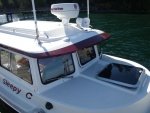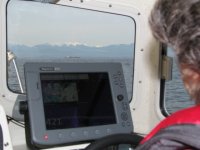I'm starting with a clean slate on electronics, and driving myself batty with all of the choices - and my lack of knowledge in the area!
I don't want to rush the decision, but I also don't want to ruminate on this forever, either. I do have an 'event' on Labor Day weekend that I'd like to be up and running for.
Salespeople haven't been particularly helpful... they just seem to peddle what they have available, or what their boss told them to peddle, or what will get them the best bonus. I've dug through the forums here - I've watched some review-type YouTube videos... a lot of the info is dated.
Do any of you keep abreast of the latest and greatest - perhaps a continuous "wish list" of how you would re-do things if/when you re-do them?
I've looked at the marketing info for Humminbird, Garmin, Lowrance and SimRad (so far) and I'm having a tough time sorting out the important differences. They all seem to have networked boat concept, high res side-scanning sonar, potential integration with radar, etc.
I'm thinking / hoping someone out there might be able to say something that turns the lightbulb on for me. I'm very much a newbie in the boat ownership world - but I don't want to buy something that I end up replacing in a year.
I don't plan to add radar yet, but it's a real possibility to add in the next year or two. I do like the newer high-res sonar. So far, I'd have to say I'm leaning towards Humminbird or Garmin... but that could just be because I've seen better sales presentations of each of those.
I'm not overly constrained by $$ - but I am not a "shovel money overboard" type person either... if that makes sense. If I can justify the expense as being worth it, I'll spend it. But if I can find good compromises by going with last year's hot model over this year's model or a 10" screen over a 12" screen, I'm fine with that.
Hopefully that gives someone enough info to give me a few tips that might point me in a good direction? Even if you've seen a particularly good YouTube video or blog post lately that might help, I'd appreciate it.
I *do* like the idea of having a portable wireless screen (iPad of whatever) available in the cockpit... I have more than one tablet device sitting around waiting to be used.
I don't want to rush the decision, but I also don't want to ruminate on this forever, either. I do have an 'event' on Labor Day weekend that I'd like to be up and running for.
Salespeople haven't been particularly helpful... they just seem to peddle what they have available, or what their boss told them to peddle, or what will get them the best bonus. I've dug through the forums here - I've watched some review-type YouTube videos... a lot of the info is dated.
Do any of you keep abreast of the latest and greatest - perhaps a continuous "wish list" of how you would re-do things if/when you re-do them?
I've looked at the marketing info for Humminbird, Garmin, Lowrance and SimRad (so far) and I'm having a tough time sorting out the important differences. They all seem to have networked boat concept, high res side-scanning sonar, potential integration with radar, etc.
I'm thinking / hoping someone out there might be able to say something that turns the lightbulb on for me. I'm very much a newbie in the boat ownership world - but I don't want to buy something that I end up replacing in a year.
I don't plan to add radar yet, but it's a real possibility to add in the next year or two. I do like the newer high-res sonar. So far, I'd have to say I'm leaning towards Humminbird or Garmin... but that could just be because I've seen better sales presentations of each of those.
I'm not overly constrained by $$ - but I am not a "shovel money overboard" type person either... if that makes sense. If I can justify the expense as being worth it, I'll spend it. But if I can find good compromises by going with last year's hot model over this year's model or a 10" screen over a 12" screen, I'm fine with that.
Hopefully that gives someone enough info to give me a few tips that might point me in a good direction? Even if you've seen a particularly good YouTube video or blog post lately that might help, I'd appreciate it.
I *do* like the idea of having a portable wireless screen (iPad of whatever) available in the cockpit... I have more than one tablet device sitting around waiting to be used.






